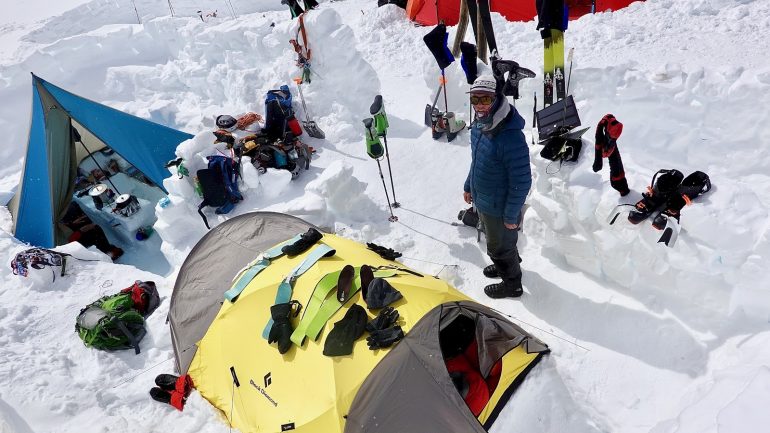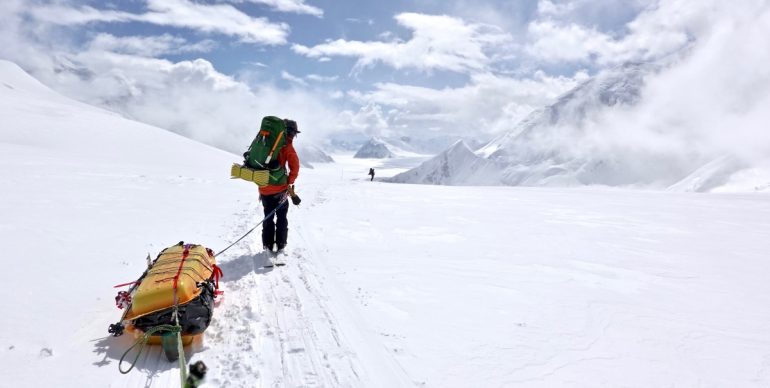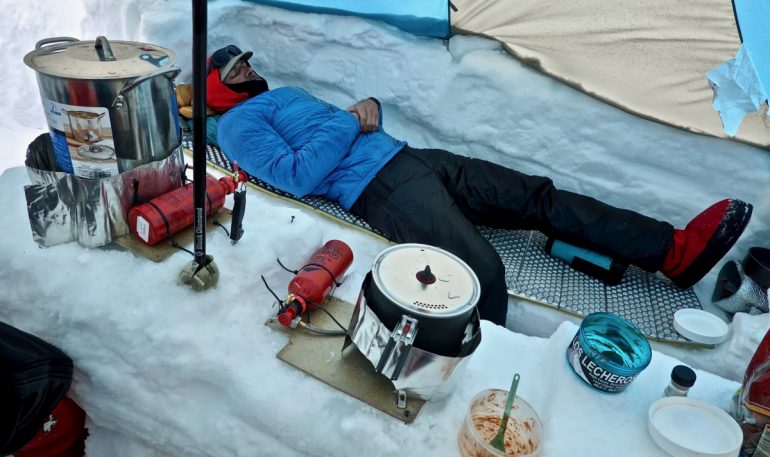Tech Tuesday is recurring segment sponsored by Dynafit to get you in the right touring gear and make sure you know how to use it.
Denali expedition tips on sleds, food, electronics and more
The gear…. holy cow the gear! Preparing the necessary gear for a ski trip on Denali is a part time job, and should be treated as such. Cal Orlowski, Drew Warkentin and myself spent two weeks on the western side of Denali this past May and June. Our main goal was to ski from the summit, climbing the standard West Buttress route and descending the Messner Couloir if it was available. The Alaska Range was in rare ski shape this spring. After acquiring said gear and skiing like mad men in our high altitude home mountains of Colorado, we were ready for the opportunity.
We started hiking around 8 p.m. on May 20th, reached 14k Camp in about 52 hours, and went for the summit only three days later. In an altitude and exhaustion induced delirium, we ended our climb on the summit ridge only 500 vertical feet short, yet skied the Messner back to camp. We rested and skied some more around camp, then climbed the Orient Express to the summit, and skied the Orient in once in a lifetime conditions. In total, we climbed the Rescue Gully twice, West Buttress Headwall, and Orient Express. We skied the Rescue Gully, Sunnyside, Orient and Messner in addition to many powder laps around camps. It was the ski trip of a lifetime and an incredibly successful two weeks.
Our team leaned heavily on many friends for loaned gear, and, more importantly, for advice about what did and did not work for them on Denali. We count Lou, Leif Whittaker, Aaron Diamond, and more amongst those friends. Their words here on Wild Snow were a tremendous help. So I’ll attempt to add to the collective knowledge here in the 2019 version of “What Worked and What Didn’t.”
Sleds, large packs, and hauling logistics
I’ll spend some time on this since I had a lot of questions about hauling logistics going into the trip. We opted to use just two of the loaner kiddie sleds which all air taxis provide (Sheldon in our case). The majority of the sled cargo was contained by an XL North Face Base Camp duffel and 100L Patagonia Black Hole bag.
The first two guys on the rope team towed sleds, while the rear person rested, enjoyed the views, and took photos on the way up to 11k Camp. The rear person in the team would not have the option to clove hitch the back of a sled to the team’s rope, making a potential crevasse fall rescue more difficult and painful for the victim. We also had one less sled to cache and to deal with on the return.
This system worked well and the rest time it provided for the rear guy was amazing. The caveat is you have to be very equal with weight or have great friends on your team. Drew and I brought more weight, mainly camera gear and a separate ski pack. Cal is both a good friend and strong pack mule, but will probably make the case for three individual sleds on our next mission. We were all newbies to towing sleds in glaciated terrain, I would love to hear from seasoned pros in the comments whether our system is a reasonable one.
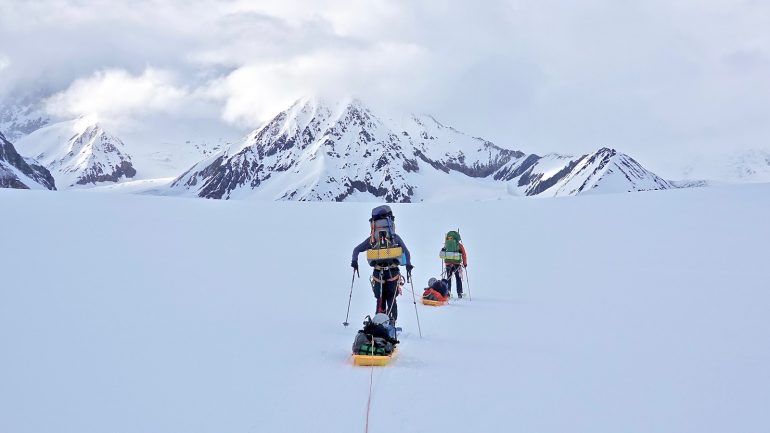
I enjoyed the first shift on the sled-free end of the rope. Lower Kahiltna Glacier. Photo @g.allen.smith
We cached the sleds and duffels, and double carried using only our packs from 11k Camp to 14k Camp. All three wore Osprey packs with Cal and I sporting the Aether Pro 70 and Drew the Aether AG 70. This trip confirmed that Osprey does a fantastic job with large packs. We attached the sleds at two conveniently located points to the pack belts. I used a bungee as well for shock absorption.
The return ski from 14k Camp back to 11k cache was a bit of a spectacle. Drew and I had our extra ski packs full and strapped on our chest Baby Bjorn style, while Cal had our groover toilet strapped to the back of his pack. We had seen the route with no new snow on two trips up and were confident in skiing un-roped, despite the now 12-16 inches of AK range powder. It was a riot to ski past climbing groups in over the shoulder snow while loaded with everything we had not eaten, burned or given away.
At 11k Camp we retrieved our cache, loaded up one sled with well over a hundred pounds of gear, and capped it with the other sled. We then rigged up a tail rope and took off down hill, running the sled like a rescue toboggan with scouter, driver and tailroper. After some early struggles, it was like the old days when we ski patrolled on Vail Mountain together. Just after Ski Hill, temperatures warmed and we roped up for the ski and skate to Heartbreak Hill and the final skimo-paced climb to our cached beers at Base Camp.
The best advice I’d gotten from Lou was to ditch the sleds and double carry from 11 Camp. Just remember you really don’t want to double down carry. Plan accordingly. Combining gear to free up a tailroper per sled is extremely helpful. I would rather tail rope 3-4 times the weight than run one solo. Remain flexible in your plan, know your strengths and limitations, and carry extra accessory cord and carabiners to tailor your team’s approach to yourselves and the conditions.
Cook tent and kitchen
Nothing special here, the Black Diamond Mega Light (formerly the Mega Mid) is great, but only as great as the setup. With the Mega Light or comparable tent, make sure to leave 10-12 inches of snow surface to overlap in order to bury the edges of the tarp. The winds can be ferocious and will rip right through open sides. A modification that we didn’t have time to do is sewing on nylon flaps (cut from an old tent) to bury. Then you can dig the full footprint of the tent, adding roughly 24 square feet of precious communal space. Down/rest days can be spent nesting in your campsite and fine tuning snow benches, cubby holes, and kitchen counter, all of which will melt and need reshaping.
We had one MSR Whisperlite and one Dragonfly stove. The Dragonfly’s dual valve design allows for fine tuning the flame to really perfect culinary art such as tuna quesadillas and butter fried cliff bars. I made some mediocre stove boards out of 3/16” plywood and notched in holes for the stove feet. I regret not having an option to gang up two stoves under the water-melting pot as team Dawson did. Readers, please comment below on good large, lightweight pots for melting snow. We ended up with an eleventh hour Walmart option. Nalgene screw top bowls worked great as eating containers. A plastic spoon would have been less cold in the hands than my titanium one.
Food
Breakfast foods were almost all freeze dried, with four different flavors (biscuits and gravy with added butter was a team favorite. Blueberry crumble a close second). Oatmeal supplemented a few days here and there. Dinner was about two thirds freeze dried foods and one third quesadillas. We wished we had bought better quality cheese, butter and tortillas since we ate so much of those. Salmon packets froze harder did not go over well, but tuna packets were good and added protein to the quesadillas. Dessert was generally a hit. We enjoyed a couple of freeze dried options, and the new-to-us discovery of the butter fried cliff bar. Our friends and neighbors at 14k camp brought us a Nutella/tortilla crepe that lifted our spirits on a down day. Soups and Pringles rounded out the in-camp snacks. A variety of bars and gels kept us fueled while on the move.
Hot drink options, as Leif mentioned last year, are a must. We had a wide variety of teas, NUUN tablets in hot water, and, of course, coffee. The instant coffee from First Ascent Coffee Roasters out of Crested Butte, CO is super tasty and less harsh than a Starbucks Via. We brought each of their blends and sometimes mixed it with Trader Joe’s creamer-included instant for an easy mountain latte. Thanks for that idea, Leif.
Solar Panel/ Electronics
Drew brought a small Goal Zero 7w and I picked up a 21w Ryno for about the same price on Amazon. The Ryno’s triple wattage and two USB ports made it a clear winner. The panel could even pick up a very slight charge while doubling as a dice board for games of solar panel Farkle. We charged iPhones for music, pictures and navigation, an InReach for communication, camera batteries, kindle, and my heated socks.
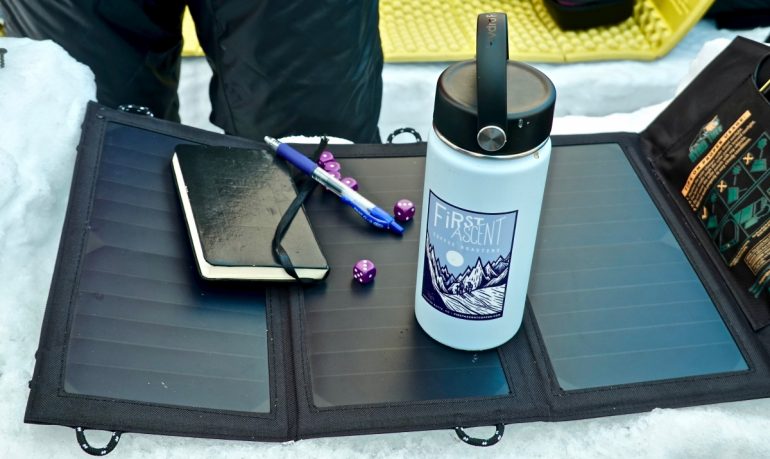
The Ryno 21w solar panel could be used as a dice board while charging “indoors.” Even the tasty First Ascent coffee couldn’t keep me sharp enough to beat Drew in Farkle.
Sleeping system
We slept in a Black Diamond Bombshelter tent. Though it is listed as a four person tent, we found it quite snug and would not have had room for a fourth. The tent was certainly bomber during the storms, barely flinching in the Alaska Range winds. All three used a Thermarest Z Lite pad and inflatable mattress combo. The Z Lites are necessary, doubling as the seat pad for cook tent snow benches.
The whole team slept in Inferno bags from The North Face and were very happy with them. Cal and I were in a -20 and Drew the -40. Ironically, Drew was the coldest sleeper of the trip even though he had the loftier bag and slept in the middle. My bag was the long version while Cal sported the regular. With Cal’s only gripe being cold feet, we concluded that the long is essential for anyone over 5’ 10” or so and would be enjoyed by all but the shortest of climbers given how much extra gear you sleep with to prevent freezing. Each night I slept with ski boot liners, 32oz Nalgene water bottle (filled hot before bed, I’ll never make the mistake of sleeping with a cold one again), the next day’s socks and most electronics. Ear plugs and sleep masks are important since it’s never dark and 14k Camp is a 24-hour metropolis. I also brought some Xanax and used a 1/4 mg dose to aid sleep.
Self Care
The usual recommendations of baby wipes, tooth care, etc. are all good. A professional dental cleaning just before the trip would be fantastic. Make sure to dry your feet out or take further preventative action if you are particularly sweaty. Cut your finger and toenails a bit long. Manage your bowel movement schedule as best as possible. I ill-advisedly used a laxative tea and had to make emergency stops. Doing the deed and then carrying it in your pack on a summit bid is rather unfortunate, or both summit bids in my case.
Physically, it’s important to stretch and move, even if you are feeling sick while acclimatizing. But don’t push it. Drew and I both had to take half days and sleep all morning without advance warning. It takes great teammates to shelf or alter the day’s objective without question; be that teammate.
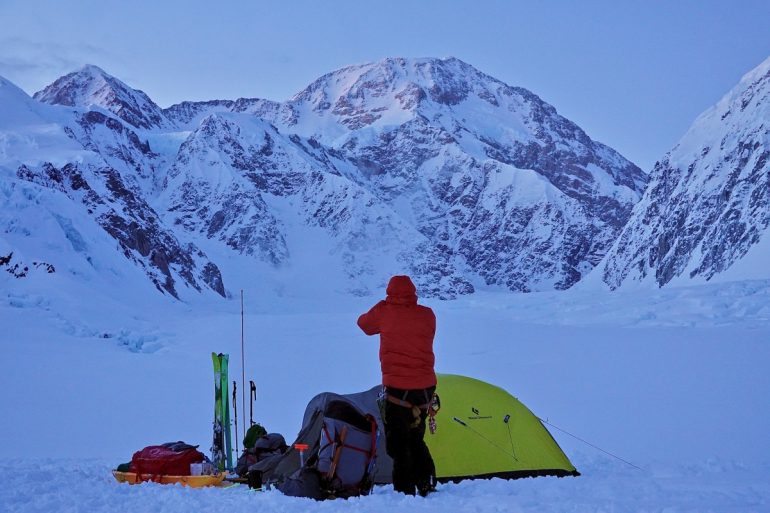
Cal is a religious twice a day flosser. Night one he enjoyed a perfect view of the summit while flossing at our camp on the Lower Kahiltna. Photo @g.allen.smith
I also want to touch a bit on mental self care. Prolonged tent time in cold weather is difficult where storm days, rest days, weather uncertainty, group dynamics and failed missions can take a toll on you. Talk a lot with your teammates about how it is all going, how they are feeling mentally and physically, and know what you need.
I am rather claustrophobic and restless — two challenges while enduring storms. This meant suiting up, throwing in the headphones, and jogging laps up and down the main thoroughfare followed by blizzard yoga in our camp. You can imagine the looks I got, but without it I may have lost my head with my team or become disenchanted with the process. We missed the summit yet skied our main ski goal on our first attempt. It took some fortitude to recover, wait out a storm, better acclimatize, remain focused and get the summit a few days later. The reward was a beautiful sunny top out and then 5,000 feet of powder on the Orient Express.
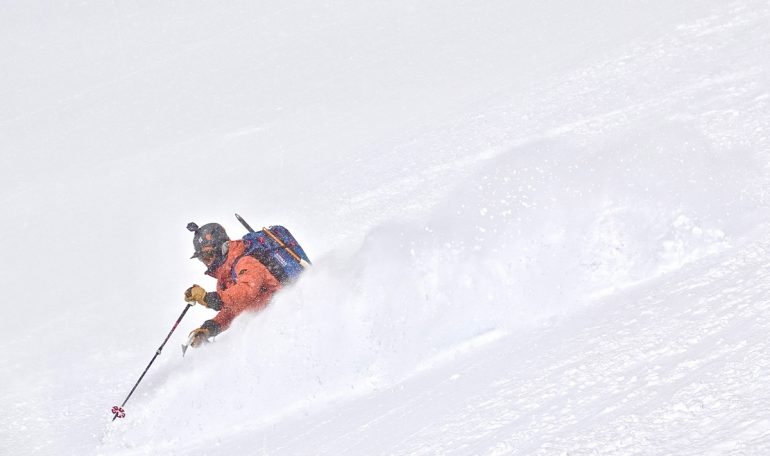
Perseverance pays off. A second and successful crack at the summit with lifetime conditions on one of Denali’s bigger ski lines. Drew in the middle of the Orient.Photo @g.allen.smith
What Worked, What Didn’t Part II – Gary goes deep into skis, boots, bindings, crampons, clothing and more.
WildSnow guest blogger Gary Smith is an avid backcountry skier and ski mountaineer residing in Eagle County, Colorado.
On March 22nd 2021, Gary Smith tragically died in an avalanche outside of Beaver Creek Resort in Colorado. Since 2018, Gary has been a frequent and insightful contributor to WildSnow. From Christmas Eve spent at the Wildsnow Field HQ cabin, to testing gear and sharing his love for steep skiing around the world, he was a pillar of the ski touring community and will be greatly missed.

